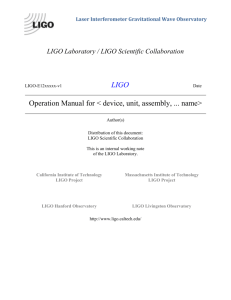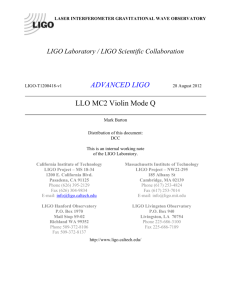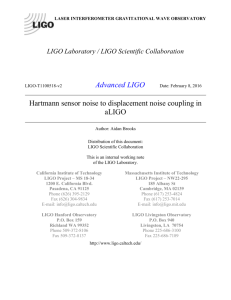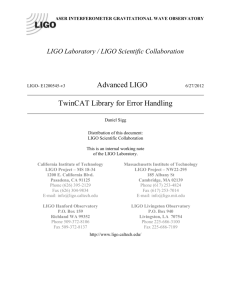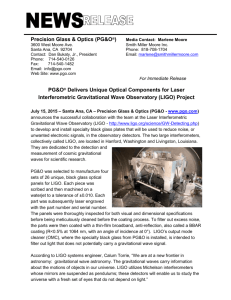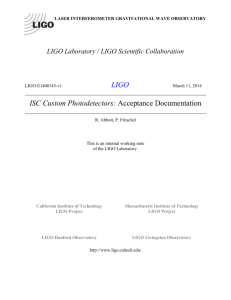T1400450-v4 HSTS Middle Mass Redesign Final Review
advertisement
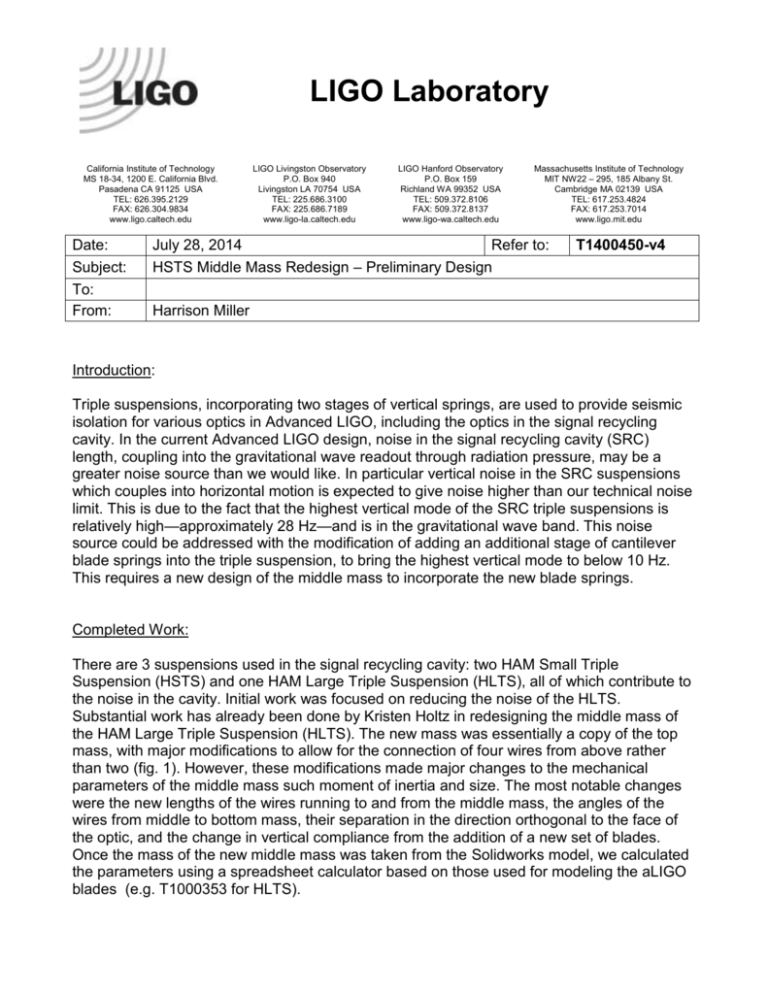
LIGO Laboratory California Institute of Technology MS 18-34, 1200 E. California Blvd. Pasadena CA 91125 USA TEL: 626.395.2129 FAX: 626.304.9834 www.ligo.caltech.edu Date: Subject: To: From: LIGO Livingston Observatory P.O. Box 940 Livingston LA 70754 USA TEL: 225.686.3100 FAX: 225.686.7189 www.ligo-la.caltech.edu LIGO Hanford Observatory P.O. Box 159 Richland WA 99352 USA TEL: 509.372.8106 FAX: 509.372.8137 www.ligo-wa.caltech.edu Massachusetts Institute of Technology MIT NW22 – 295, 185 Albany St. Cambridge MA 02139 USA TEL: 617.253.4824 FAX: 617.253.7014 www.ligo.mit.edu July 28, 2014 Refer to: HSTS Middle Mass Redesign – Preliminary Design T1400450-v4 Harrison Miller Introduction: Triple suspensions, incorporating two stages of vertical springs, are used to provide seismic isolation for various optics in Advanced LIGO, including the optics in the signal recycling cavity. In the current Advanced LIGO design, noise in the signal recycling cavity (SRC) length, coupling into the gravitational wave readout through radiation pressure, may be a greater noise source than we would like. In particular vertical noise in the SRC suspensions which couples into horizontal motion is expected to give noise higher than our technical noise limit. This is due to the fact that the highest vertical mode of the SRC triple suspensions is relatively high—approximately 28 Hz—and is in the gravitational wave band. This noise source could be addressed with the modification of adding an additional stage of cantilever blade springs into the triple suspension, to bring the highest vertical mode to below 10 Hz. This requires a new design of the middle mass to incorporate the new blade springs. Completed Work: There are 3 suspensions used in the signal recycling cavity: two HAM Small Triple Suspension (HSTS) and one HAM Large Triple Suspension (HLTS), all of which contribute to the noise in the cavity. Initial work was focused on reducing the noise of the HLTS. Substantial work has already been done by Kristen Holtz in redesigning the middle mass of the HAM Large Triple Suspension (HLTS). The new mass was essentially a copy of the top mass, with major modifications to allow for the connection of four wires from above rather than two (fig. 1). However, these modifications made major changes to the mechanical parameters of the middle mass such moment of inertia and size. The most notable changes were the new lengths of the wires running to and from the middle mass, the angles of the wires from middle to bottom mass, their separation in the direction orthogonal to the face of the optic, and the change in vertical compliance from the addition of a new set of blades. Once the mass of the new middle mass was taken from the Solidworks model, we calculated the parameters using a spreadsheet calculator based on those used for modeling the aLIGO blades (e.g. T1000353 for HLTS). LIGO Laboratory T1400450-v4 28 July 2014 Figure 1: Original middle mass (A) and updated middle mass (B) for the HLTS. Note the added blade springs (labeled with arrows) and drastic changes in size, shape, wire length, etc. The next step was to then model the seismic noise transfer functions of the new suspension in MATLAB, using the new parameters, to ensure that adding the extra set of blade springs would have the desired effect of bringing the vertical mode to below 10 Hz. Transfer functions for the new model were plotted with ones for the old model for comparison. As seen in the plots below (Fig. 2), the addition of the new stage of blades successfully lowered the vertical mode down to about 5 Hz. Figure 2: Transfer function of Vertical Suspension Point to Vertical Stage 3. Note that the peak for the highest vertical mode has been pushed back under 10 Hz. LIGO LABORATORY (Form F0900036-v2) Page 2 of 10 LIGO Laboratory T1400450-v4 28 July 2014 After this work on the HLTS was completed, it was recognized that it would be more important to focus our redesign work on the HSTS for the following reason. The optical layout for the recycling cavity is such that the mirror normals for SR3 (HLTS) and SR2 (HSTS) are both perpendicular to local g, whereas for the SRM (HSTS) there is an explicit pitch of the mirror to retro-reflect the beam. Due to this pitch, vertical to horizontal coupling for the SRM is larger than for SR3 and SR2. Thus, SRM has more horizontal displacement noise due to vertical motion than the other mirrors, and hence increasing its vertical isolation will have more effect on improving the performance of the recycling cavity. We carried the same methods used in redesigning the HLTS over to the HSTS by first copying the design of the top mass for a new middle mass. However, the top mass as it stood would not allow for the use of existing actuators on the middle mass due to their spacing. So, it was clear that some modifications needed to be made. As a proof of concept, we added a bottom plate that would allow for the same actuator placement as the old middle mass. We also changed the material of the bottom pieces from steel to aluminum in an attempt to keep a similar total mass as well as center of mass (fig. 3). It became apparent that, not only were there various ways to allow for the proper actuator placement, but accommodations also needed to be made for the attachment of two new wires coming from the top mass, taking total to 4 wires, as well as the blades on the bottom Figure 3: Proof of concept for new HSTS middle mass. Grey lines mark position of wires and white dots marking OSEM magnets LIGO LABORATORY (Form F0900036-v2) Page 3 of 10 LIGO Laboratory T1400450-v4 28 July 2014 A) B) Figure 4: A) Old middle mass B) new middle mass Original New Moment of Inertia (Kg*m^2) Lxx = .00531 Lyy = .00635 Lzz = .00889 Lxx = .00580 Lyy = .01646 Lzz = .02017 Mass (Kg) 2.981743 2.9116 Figure 5: data from original middle mass and new middle mass in Solidworks coordinates system. This first redesign has drastically changed the mass properties of the mass. Figure 6: Diagram of transformation from SW coordinates to MATLAB coordinates A) B) Figure 7: A) Original top mass and B) redesigned middle mass. The bottom piece was added to accommodate OSEM magnets. However, even after changing the material from stainless steel (red) to aluminum (grey), the center of mass has still been shifted too far below the blades. LIGO LABORATORY (Form F0900036-v2) Page 4 of 10 LIGO Laboratory T1400450-v4 28 July 2014 For the OSEMs to work properly without having to rewrite lots of control loops, we needed the center of mass to coincide with the center of the four OSEM magnets. However, the blades also needed to be located just below the center of mass for stability. So, we needed a design that drastically moved the blades down, but also remained stiff enough that internal modes would not be a concern. The end result was a triangular brace that attaches to the top plate and holds the blade at a reasonable height (Fig 8). To ensure this design would be acceptable, modal analysis was performed on the top plate with the triangle braces. Figure 8: Triangle brace to hold blade Mode Figure 9: Deformation of top plate with triangle braces and resulting modes 1 Frequency (Hz) 169.91 2 190.97 3 307.55 4 733.43 5 854.14 6 1266.4 It was determined that keeping the same wire separation in the direction of the laser beam between the wires going from the middle mass to the bottom mass would be ideal, as we would not have to redesign any part of the bottom mass. However, adding two blades to each side of the middle mass-four blades total-would not allow us to keep such a small separation (1 cm). It was suggested that we attempt a two-blade design, with one clamp at the end of the blade that could hold both wires at the correct distance. After looking at the resulting transfer functions of a two-blade design, we decided to pursue that option. Because the blades placed the wire break-off farther towards the center than previously, the wires holding LIGO LABORATORY (Form F0900036-v2) Page 5 of 10 LIGO Laboratory T1400450-v4 28 July 2014 the bottom mass now break-off at an angle (previously the wires broke off vertically from the middle mass). This was compensated for in the new clamp design. Figure 10: new two-wire blade clamp. The clamp is angled to account for the new angle of the wires. There are also two notches for wires instead of one The next step was to design clamps that could hold the wires coming from the top mass. Here, we wanted to be able to replace the middle mass completely without having to redesign the top mass at all. So, we needed clamps that would preserve the angle of the wires from the top mass, the wire separation, and the vertical distance of the masses. An initial design was created and holes were added to the top plate such that the clamp could be attached from below (Fig. 11). However, once these clamps were in place, the wire separation in the direction of the laser beam was too small. The clamp was modified, creating a handed version of the clamp, but it was decided that having left-handed and right-handed versions of the same clamp was bad for assembly. So, we made modifications to the top plate such that we could go back to the symmetric design and maintain the correct wire separation. Figure 11: Clamp design. The angle of the clamp preserves the angle of the wires coming from the top mass, and the holes on top allow the clamp to attach to the top plate from below. LIGO LABORATORY (Form F0900036-v2) Page 6 of 10 LIGO Laboratory T1400450-v4 28 July 2014 Figure 12: Top plate design. The four outside slots allow for the wire to pass through to the top mass, as well as providing room for the wire clamp to fit through. The two slots in the middle allow access to the blades. The four square sections coming out from the edge allow the clamps holding the wires from the top mass to be the appropriate distance apart. We wanted to retain the ability to adjust the pitch and roll of the mass, so we added adjusters similar to previous designs. To measure the effectiveness of these adjusters, the center of mass and moments of inertia were first found for both masses and recorded. The pitch adjuster was then moved in the Z-direction (Solidworks coordinate frame) and the COM and MOI were found again. The following table shows the movement of the COM after moving the pitch adjuster 5mm, 10mm, etc. Figure 13: New middle mass with pitch and roll adjusters circled in yellow. They can be slid in and out to adjust the roll and pitch of the mass. Mass 0mm Upper (-.3, -20.06, -0.0) New Middle (.12, -51.72, -0.1) Center of mass 5mm (-.3, -20.06, .33) (X,Y,Z) in mm 10mm (-.3, -20.06, .67) after pitch adjust 15mm (-.3, -20.06, 1.01) 25mm (-.3, -20.06, 1.68) (.12, -51.72, .39) (.12, -51.72, .80) (.12, -51.72, 1.2) (.12, -51.72, 2.01) From this data, moving the pitch adjuster 5mm in the positive Z direction shifts the COM about .4 mm in the same direction. Similar tests can be done to find the effect of the roll adjuster. LIGO LABORATORY (Form F0900036-v2) Page 7 of 10 LIGO Laboratory T1400450-v4 28 July 2014 We then wanted to do an FEA analysis of the new blades as well as the overall mass. For the blades, we ran FEA with both ends of the blade fixed so that we only saw the high-frequency, “guitar string”-type modes. Figure 14: Blade model with fixed supports on both ends and the resulting first six modes mode Frequency (Hz) 1 391.56 2 1092.3 3 2194.8 4 3085.7 5 3729.6 6 4942.5 The overall mass was run with no fixed supports to find the so called “wing mode.” This occurred at the 6th mode, 217.03 Hz. The remaining five modes are three seemingly “rotational” modes and two blade modes (the blade modes are modes 2 and 3 and are very close at 33.12 and 33.144 Hz). mode Frequency (Hz) 1 16.391 2 33.12 3 33.144 4 36.926 5 62.869 6 217.03 Figure 15: FEA of HSTS middle mass and corresponding mode frequencies At this point we are ready to begin planning to prototype the new HSTS. The first step is to create an overall Solidworks rendering of the HSTS with the new middle mass in place to make sure all of the dimensions line up and that the wires will not interfere with anything. LIGO LABORATORY (Form F0900036-v2) Page 8 of 10 LIGO Laboratory T1400450-v4 28 July 2014 Figure 16: Front and side views of overall rendering of overall HSTS with new middle mass. Refer to D1400253 LIGO LABORATORY (Form F0900036-v2) Page 9 of 10 LIGO Laboratory Part Mainsection wireclamp wireclamp inside wireclamp outside triangle brace upper blade clamp lower blade clamp two-wire blade clamp inside two-wire blade clamp outside T-section for middle mass bottom section for middle mass bottom Bracket T1400450-v4 28 July 2014 DCC # D1400197 D1400198 D1400199 D1400200 D1400201 D1400202 D1400203 D1400204 D1400205 D1400206 D1400207 D1400210 Figure 17: List of relevant HSTS middle mass parts and their DCC numbers LIGO LABORATORY (Form F0900036-v2) Page 10 of 10
